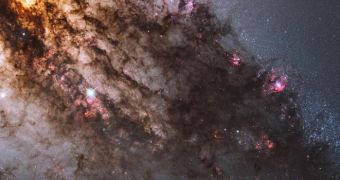The galaxy Centaurus A was recently the object of a new scientific study conducted by astronomers using the NASA Hubble Space Telescope. The team was able to produce a panchromatic view of the galaxy's central areas, where blue stars are lighting up the formation from within.
They are producing a vibrant glow that is invisible to optical observatories. Hubble collected this image in portions of the electromagnetic spectrum ranging from near-infrared to ultraviolet, as this enabled it to pierce through the gas and dust clouds surrounding the stellar nursery.
Centaurus A looks this way because it was severely affected by a collision with another galaxy, some time ago. The object is located about 11 million light-years away, and is the closest active galactic nucleus (AGN) to Earth.
Astronomers say that the shockwaves produced by the recent collision caused “hydrogen gas clouds to compress, triggering a firestorm of new star formation. These are visible in the red patches in this Hubble close-up.”

 14 DAY TRIAL //
14 DAY TRIAL //